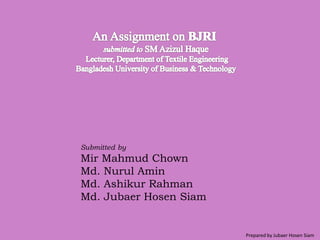BJRI (Bangladesh Jute Research Institute)
- 1. Submitted by Mir Mahmud Chown Md. Nurul Amin Md. Ashikur Rahman Md. Jubaer Hosen Siam Prepared by Jubaer Hosen Siam
- 2. BJRI Bangladesh Jute Research Institute
- 4. ’āśJute research first started in Dhaka by Sir RS Finlow in 1904. ’āśThe present form of this institute is developed from the first Jute Agricultural Research Laboratory (JARL) established by the Indian Central Jute Committee (ICJC) at Dhaka in 1936. ’āśAfter the liberation war of Bangladesh in 1971 Jute Sector was taken up by the government & declared as BJRI or Bangladesh Jute Research Institute in 1974. ’āśAnd in 1996 it was modified with some major functions.
- 5. Raw Jute
- 6. (a) To regulate, control and promote agricultural, technological and economic research on jute and allied fibers. (b) To organize production, testing and supply of improved pedigree jute seeds and their multiplication, attainment and distribution to recognized organizations, selected growers, and such other agencies as may be approved by the board. Objectives
- 7. Fields of Research #Agricultural Research on Jute At present BJRI is conducting researches with two wings, #Technological Research on Jute
- 8. Recent success of BJRI The genome sequence of Tossa and desi jute has been discovered by BJRI scientists in 2009 and in 2013 Genome sequence of devastating fungal pathogen Macrophomina Phaseolina has been discovered. Mission Development of sustainable technologies through agricultural and industrial researches on jute and allied fiber crops for incoming generation, socio- economic development, environment protection and poverty alleviation of farmers and other stakeholders by dissemination the developed technologies.










